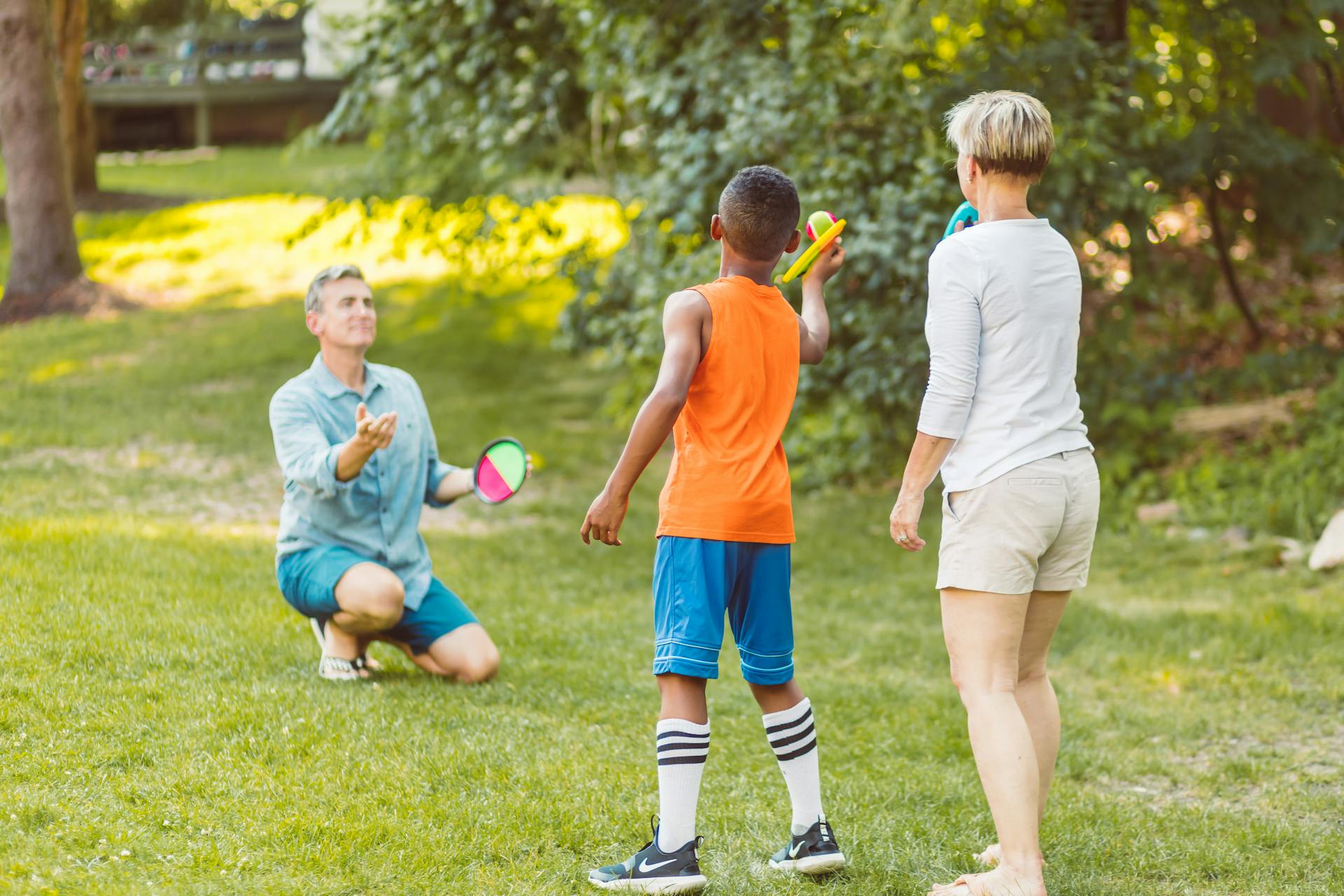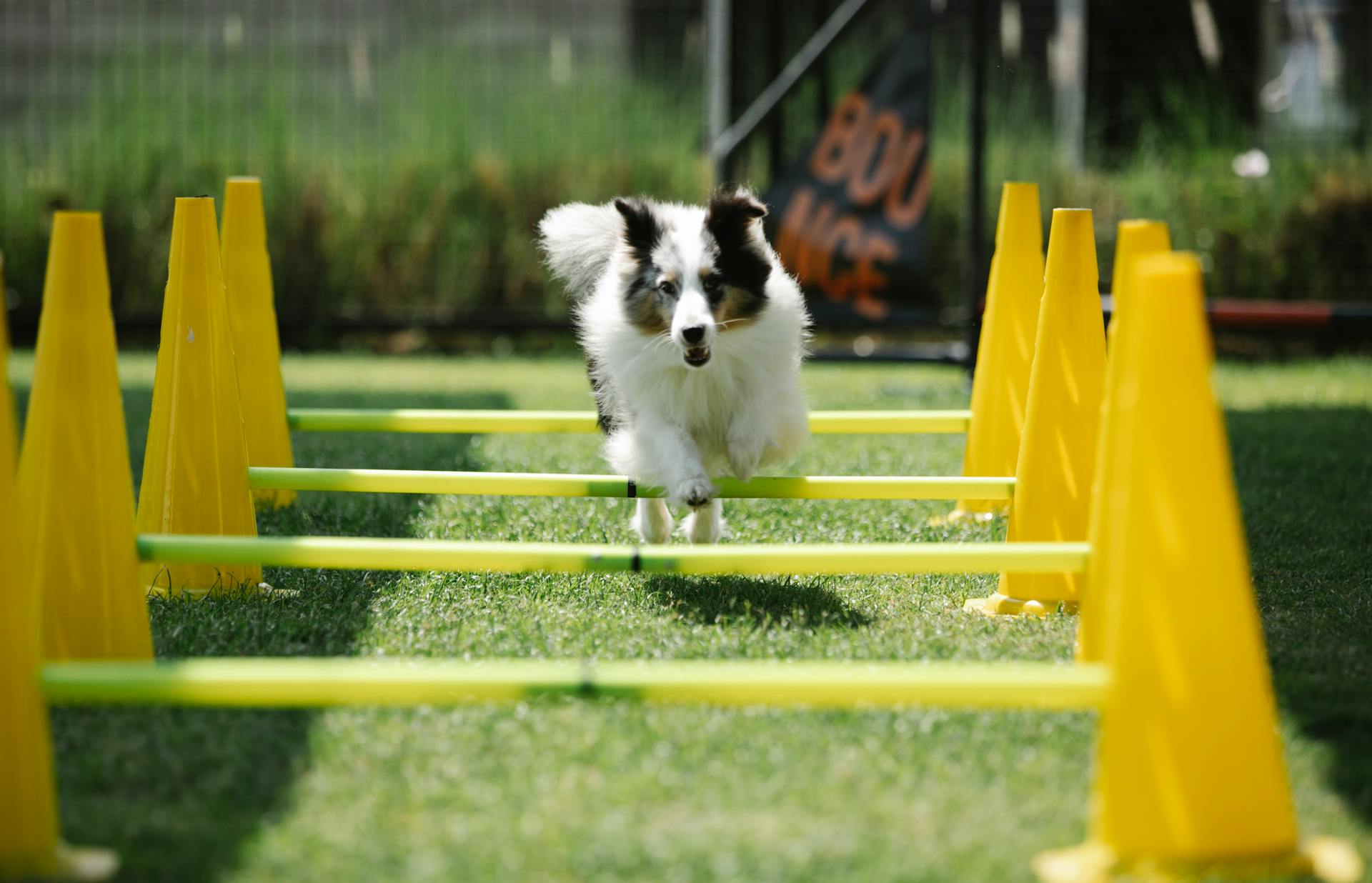
Velcro dogs can be a handful, but don't worry, with some simple adjustments, you can help your furry friend become more independent.
The first step is to identify the reasons behind your dog's Velcro behavior. According to our research, separation anxiety is a common cause, and it's often triggered by changes in your work schedule or moving to a new home.
Dogs thrive on routine, so establishing a consistent daily schedule can help your pet feel more secure. This includes regular feeding times, exercise, and playtime.
By giving your dog plenty of physical and mental stimulation, you can reduce the likelihood of separation anxiety.
Take a look at this: Do Dog Diapers Help with Potty Training
Understanding Velcro Dog Behavior
Velcro dog behavior is a common issue that can be challenging to address, but understanding its causes is key to finding a solution.
Clingy dogs, also known as Velcro dogs, are dogs that are especially clingy and attached to their owners, often seeking constant attention, affection, and reassurance.
This behavior can be based on dog anxiety or learned from their environment, and it's essential to identify the underlying cause to address it effectively.
Some breeds, such as lap dogs, are more prone to being Velcro dogs due to their breeding history, and certain behaviors, like letting them sleep in your bed, can create a dependence on being close to you.
However, this behavior can also be a sign of other issues, such as anxiety or a lack of training, so it's crucial to consult with a veterinarian or a professional dog trainer if you're concerned about your dog's behavior.
Understanding that Velcro dog behavior is not the dog's fault, but rather a learned behavior, can help you approach the issue with compassion and patience.
A sudden onset of clingy behavior in dogs may be a sign of an underlying health issue, so it's essential to rule out any medical problems before addressing the behavior.
Identifying the underlying cause of clingy behavior in dogs is crucial to address it effectively, and a veterinarian or a professional dog trainer can help determine the cause and develop a plan to help the dog become more comfortable and confident.
Causes and Characteristics
Velcro dogs are characterized by their strong desire to be close to their owners. They exhibit behaviors such as following their owners around a room or between rooms, always watching them, and sleeping or sitting as close as possible.
Some breeds, like lap dogs, are more likely to be velcro dogs because they've been bred to be more dependent. German Shepherds, which have been bred to work alongside their owners, are also prone to being velcro dogs.
Velcro dog behavior can stem from a dog's natural instinct to be part of a pack and seek security from their human "pack leader." It can also be influenced by socialization and early bonding experiences.
Here are some common characteristics of velcro dogs:
- Following you from room to room
- Constantly needing or wanting to be next to you
- Keeping an eye on you at all times
- Anticipating when you may be getting up
- Always wanting to be where the action is
Signs of Velcro Formation
Dogs with Velcro dog syndrome tend to follow their owners everywhere they go, seeking constant attention and affection. This can be a result of various factors, including lack of socialization, separation anxiety, fear or anxiety, illness, a change in routine, or genetics.

Some common signs of Velcro dog syndrome include following owners from room to room, constantly needing or wanting to be next to them, keeping an eye on them at all times, anticipating when they may be getting up, and always wanting to be where the action is.
Velcro dogs can become anxious or distressed when left alone and may exhibit destructive behavior or vocalization in response. They may also have difficulty adjusting to new people or environments, preferring to stay close to their owners.
A velcro dog is a dog that wants to be by their owner's side at all times. Certain breeds, such as lap dogs, are more likely to be velcro dogs because they've been bred to be more dependent.
Here are some common symptoms of Velcro dog syndrome:
- Following you from room to room
- Constantly needing or wanting to be next to you
- Keeping an eye on you at all times
- Anticipating when you may be getting up
- Always wanting to be where the action is
Why Do People Exhibit Certain Behaviours?
People exhibit certain behaviours due to their natural instincts, socialization, and early experiences. Velcro dog behaviour can stem from a dog's natural instinct to be part of a pack and seek security from their human "pack leader." It can also be influenced by socialization and early bonding experiences.
Our own instincts and early life experiences shape our behaviours in similar ways. For example, a dog's need for security and belonging can lead to velcro behaviour.
What Causes Existence?

Velcro dogs become clingy through owner encouragement, specifically by consistently praising and rewarding them for approaching.
Praising and rewarding your dog every time they see you sends the signal that they'll get treats and praise, which encourages them to continue this behavior.
Sleeping in your bed with your dog can create a dependency, making them feel the need to be near you all the time.
Rescue dogs are more likely to become clingy due to past traumas, possibly fearing abandonment again.
Older dogs may become clingy as they lose their sight and hearing, while a bored dog has nothing better to do than follow you around.
You might enjoy: How Can I Have a Dog and Work Full Time
Some Breeds Have Been Bred to Be Dependent on Humans
Some breeds have been bred to be dependent on humans. This is particularly true for working, herding, and hound dogs, such as Border Collies, who rely on their owners' body language and directions for guidance.
Many toy breeds were selectively bred to be lap dogs, making them naturally clingy. German Shepherds and Akitas are also known to attach themselves to one person.
Curious to learn more? Check out: Velcro Dogs Breeds
Some companion-type breeds, like Terriers, Chihuahuas, Labs, and Golden Retrievers, are also prone to being quite clingy. These breeds have been bred to be loyal and loving companions, but this can sometimes translate to excessive attachment.
Breeds that have been bred to work alongside their owners, such as German Shepherds, are more likely to be velcro dogs. This is because they've been bred to be dependent on their owners for direction and guidance.
The following breeds are known to be clingy due to their breeding history:
- Border Collie
- Terriers
- Chihuahua
- Labrador Retriever
- Golden Retriever
- German Shepherd
- Akita
- Toy breeds (e.g. Pug, Bichon Frise)
Managing Velcro Dog
Managing Velcro Dog behavior requires patience and understanding. A velcro dog is a dog that wants to be by their owners' side at all times, and certain breeds like lap dogs and German Shepherds are more prone to this behavior.
To manage velcro behavior, provide your dog with proper socialization, training, and opportunities for independent play and exercise to build confidence in being alone at times. Desensitize your dog to your movements by practicing getting up and doing mundane tasks without going somewhere important.
Teaching your dog the "Stay" or "Wait" command can also help with clinginess, and place training is a key tool that allows you to tell your dog to stay in a particular spot.
Exercise and Socialization
Exercise and socialization are key to managing a Velcro dog's behavior. A tired dog is a good dog, so make sure your furry friend gets enough physical activity.
Give your dog a daily walk, and if you're struggling to stay motivated, check out these 5 tips to help you get moving. Your dog will sleep and relax more at home if they have enough exercise.
Your dog thrives when given a purpose, so offer them acceptable behaviors instead of just telling them what not to do. If your dog starts to get clingy, it might be because they're getting bored, so take it as a cue to give them more exercise or mental stimulation.
Provide your dog with opportunities for independent play and exercise to build their confidence in being alone at times. With proper training and care, clingy dogs can become well-behaved and loving pets.
Readers also liked: How to Give Dogs Pills without Food
Desensitize Your Dog
Desensitization is a key part of managing a Velcro dog, and it starts with understanding that your dog's behavior is often a response to triggers.
You want to start slowly and show your dog that it's okay for them to stay where they are and that they don't have to follow you every time you move.
Practice moving a small amount and when your dog doesn't move you can return to them and praise them.
It does take time, but over time increase the distance that you are moving until you can go across the room without your dog following.
Getting up and doing something mundane is another way to desensitize your dog to your movements.
Practice getting up and doing something like putting on your shoes, and repeat this behavior until your dog doesn't give a reaction anymore.
Think of all the triggers that get a response from your dog, and work on desensitization with all of them, like putting down the remote.
Place Training
Place training is a game-changer for velcro dogs. It allows you to tell your dog to go to a specific spot and relax, which is especially helpful when you're busy with tasks like cooking or cleaning.
You can use your dog's bed as their 'place', but it can be anywhere. Place training is different from the "stay" command, as your dog can relax and even fall asleep while in "place".
The advantage of place training is that it keeps your dog safe and out of the way, reducing the risk of tripping or getting underfoot.
Reducing Clinginess
Separation anxiety is one of the most common causes of consulting a pet behaviorist, and if left untreated it can get worse.
If you suspect your dog has separation anxiety, I highly recommend reaching out to your veterinarian for references to find a pet behaviorist to help modify the behavior.
Dogs that are bored can develop destructive behaviors if left unattended, so giving your dog some more mental stimulation or a job to do can help relieve dog boredom.
If you're looking to teach your dog to be more independent, you can start by teaching them to be alone for short periods of time, such as when you're making dinner or cleaning the bathroom.
It's not always necessary to modify velcro dog behavior, as many of us don't mind it at all and some even find it quite flattering.
However, if your dog's clingy behavior is becoming hazardous, such as when you're cooking or cleaning, it's time to take action.
To reinforce some more independence in your dog, you can try some of the training techniques and activities mentioned in the article, such as giving your dog a job to do or engaging in fun indoor activities to keep them busy.
Training and Classes
Training and classes can be a game-changer for Velcro dogs. Several dogs enrolled in a Basic class each session cling to their handlers out of fear, but with patience and treats, they eventually become more confident pets.
Classes can be a safe space for shy dogs to take interest and join in. Within six weeks, dogs can go from being clingy to being more confident. This was the case for a Chihuahua named Muffin, who was initially very shy but became well-trained with the help of her owner.
The owner learned how to teach various exercises in class and took them home to practice with Muffin, resulting in a well-trained but still shy dog. Everyone was happy with the outcome, and it shows that classes can be a helpful tool in training Velcro dogs.
How to Train Your
Training a Velcro dog requires patience and consistency. With time and positive reinforcement, they can become more confident and less clingy.
In a class setting, shy dogs can benefit from socialization and interaction with their owners. They'll learn to take interest in the class and eventually join in.
It's essential to teach various exercises and reward good behavior with treats. This approach helped a Chihuahua named Muffin become a well-trained dog, even if she was still shy.
With the right training approach, even the most fearful dogs can make progress. It's not about forcing them to be more outgoing, but about helping them feel more secure and confident.
Stay Training
Stay training is a game-changer for dog owners, especially those with velcro dogs. It's a command that can help your dog learn to stay by your side, but also respect your personal space.
Teaching your dog the "Stay" or "Wait" command can be done with positive reinforcement training methods. This means using treats and praise to encourage good behavior.
Just the process of teaching your dog to stay will also help with their clinginess. They'll learn that even when you walk away, you'll always be back.
You can use the "Stay" command multiple times a day, and over time, your dog will learn that they don't need to follow you everywhere.
Related reading: Will Hawks Attack Small Dogs
Similar to Separation Anxiety?
A Velcro dog wants to be by your side at every possible moment, which can sometimes be mistaken for separation anxiety.
While the two are related, they're not the same thing. A dog with separation anxiety experiences panic and emotional distress when you're not around.
Velcro dog type behaviors can be a predictor of a dog developing separation anxiety in the future if left unchecked.
A dog with separation anxiety can display anxiety behaviors like chewing on things or howling when you leave, even just the room.
Health and Stress
Sudden onset of clingy behavior in dogs may be a sign of an underlying health issue, so it's essential to rule out any medical issues if your dog's behavior changes suddenly.
If your dog has started following you everywhere and there aren't any obvious triggers, make an appointment with your vet to ensure their health is okay.
Some dogs may exhibit clingy behavior due to separation anxiety, but not all velcro dogs have separation anxiety - they may simply enjoy being near their owners.
If your dog stays calm when following you around, it's likely fine, but if they get anxious when you leave, it could be a sign of separation anxiety.
A study in 2001 found that dogs with hyper-attachment to their owners are more likely to develop separation anxiety, but it's not inevitable and can be managed with the right training and approach.
Moving into a New Neighborhood Can Cause Extra Stress
Moving into a new neighborhood can cause dogs to become extra clingy. This is because dogs are highly attuned to their environment and can pick up on changes in their surroundings, which can lead to stress and anxiety.

A study in 2001 found that dogs who have hyper attachment to their owners are more likely to develop separation anxiety. This can manifest in clingy behavior, especially if your dog is used to being with you all the time.
If your dog seems extra clingy after a move, you can help them relax by sticking to a predictable routine. This can help them settle in and feel more secure in their new environment.
Some common symptoms of a dog who is feeling stressed or anxious after a move include barking or howling when you're gone, destructive chewing and destruction, and escape attempts. If you notice any of these behaviors, it's a good idea to consult with a veterinarian or a professional trainer for help.
Here are some signs that your dog may be experiencing separation anxiety:
- Barking or howling when you're gone
- Destructive chewing & destruction (such as doors, window sills, household objects)
- Escape attempts
- Excessive panting or drooling
- Urinating or defecating when you're gone
- Pacing around
- Your dog becomes anxious when you're getting ready to leave
- Your dog exhibits inappropriate behavior only when you're not there
In contrast, a velcro dog simply exhibits clingy behaviors while you're home, such as following you from room to room, constantly needing or wanting to be next to you, and keeping an eye on you at all times. If you're concerned that your dog is being too clingy, pay attention to their mood when they're following you around. If they're excited, it may be a sign that they're bored and looking for something to do.
Boredom and Mental Decline

Bored dogs are more likely to be glued to your side, saying the same thing as children: "I'm bored"! This is their way of seeking attention.
Dogs can get bored if they're not given enough mental & physical exercise, leading to Velcro dog syndrome.
A fun food game can keep your pooch amused for a long time, so try filling a Kong toy with their favorite treat or regular food.
Interactive dog toys are available in dozens of types, so it's worth looking around on Amazon to find one that appeals to your dog.
Dogs looking for something to do will leap up and follow you around, making them excited.
Broaden your view: How to Stop a Dog from Pacing around the House?
Sudden Behavioral Changes May Be Health Related
Sudden clingy behavior in dogs can be a sign of an illness.
If your dog has started following you everywhere and there aren't any obvious triggers, it's a good idea to take them to the vet to rule out any medical issues.
Sickness can cause dogs to become clingy as a coping mechanism.
This is why it's essential to pay attention to sudden changes in your dog's behavior and address them promptly.
Sudden changes in behavior can be a sign of an underlying health issue, so don't hesitate to seek veterinary care if you notice any unusual behavior in your dog.
Consider reading: Dog Suddenly Lost Hearing
Frequently Asked Questions
What creates a Velcro dog?
Routinely spoiling your dog with excessive affection can create a Velcro dog, as they associate constant attention with positive reinforcement. This can lead to a strong attachment and a desire to stay by your side 24/7.
Do all Velcro dogs have separation anxiety?
Velcro dogs may exhibit apprehension when left alone, but not necessarily full-blown separation anxiety. They should be interested in your presence, but relaxed and self-sufficient when you're not around.
Featured Images: pexels.com


